Sinclair Groupings - Overview
Click any one of these as we try to figure out all our Groups' complete path through time
 |
 |
 |
RELATED RESEARCH
DENSITY STUDY OF OUR SURNAME
THROUGHOUT THE WORLD
Where Are They Now?
As this map
shows, following our family groupings makes sense up
until about 1,500 AD. By that point, allegiances were becoming more
nationalistic and less tribal (clan tribes included). The yellow arrows
from Europe pointing into the UK came from different areas carrying
very different haplotypes. And they often came in as groups of the same
haplogroup. By the time of the Conqueror, this had changed and
different haplogroups were traveling together. They had become
nations, not tribes. They mixed together in particular geographies,
and then they launched out again.
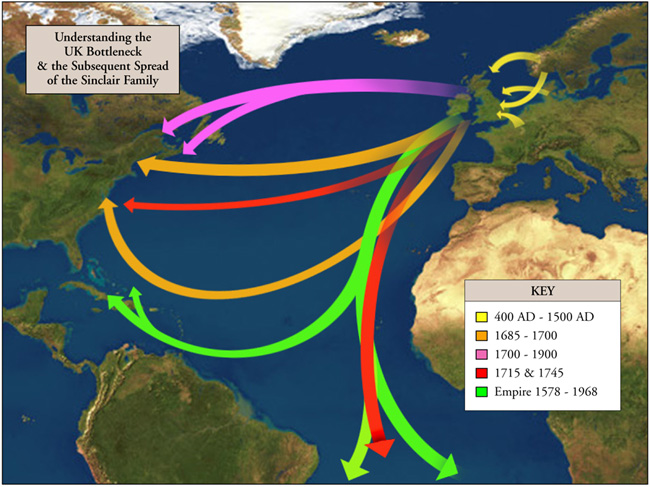
The yellow arrows represent the
invasion/migration
into the UK from the Danes, the Anglo Saxons, the Norse, and William
the Conqueror's assembled groups. These groups at first stayed together
on the eastern coast of England. But eventually, by about 1200 AD, they
had begun to move around England and Scotland for reasons altogether
different than tribal land grabs. Economic reasons for moving had taken
over. England became a bottleneck of sorts, and the bottle got shaken,
mixing everything up.
The green arrows above represent the spread of the English Empire. Our
family members are mentioned on ships traveling in the earliest parts
of the expansion of the Empire. We spread as far as South Africa,
India, the Colonies of North America, and the islands of the West
Indies.
The orange arrows were somewhat different. I view these as
opportunistic migration for purely financial reasons. The Exeter and
Virginia lines (and others) all made such moves. These were the
movements of individuals. Other family members followed to the same
areas, but only after one had succeeded in setting himself up in the
new world.
The light purple arrows represent the ongoing migration of Sinclairs to
North America and even to South America from the earliest times, most
drawn by the opportunities for more land and for better economic
conditions. These arrows also represent the forced migration of the
Clearances.
The red arrows represent those Sinclairs expelled in the final
significant clan risings of 1715 and 1745. Many were shipped off to
Australia, Virginia and the Carolinas to serve time as indentured
servants.
What does this bottleneck
mean?
Bottlenecks in any geography can make our job more difficult and this
one certainly does. Had the Visigoths stayed in their group all the way
to the present day, we wouldn't need to do much work to figure things
out. Had the E1b1s stayed together, things would be simple.
Unfortunately, documents were lost, and people moved to the Colonies as
individuals, not as haplogroups.
It is this bottleneck, the loss of tribal affiliations and the
subsequent mixing of our family members that causes much of the
confusion. Some of the Anglo-Saxon Visigoth Invader group clearly moved
north and were in western and northern Scotland sometime between c. 800
AD and 1,400 AD. These marker show up as far North as the Shetlands.
The AMH group now show up in less spread out clusters. The DYS390=25
group show up mostly in Caithness, again not as spread out.
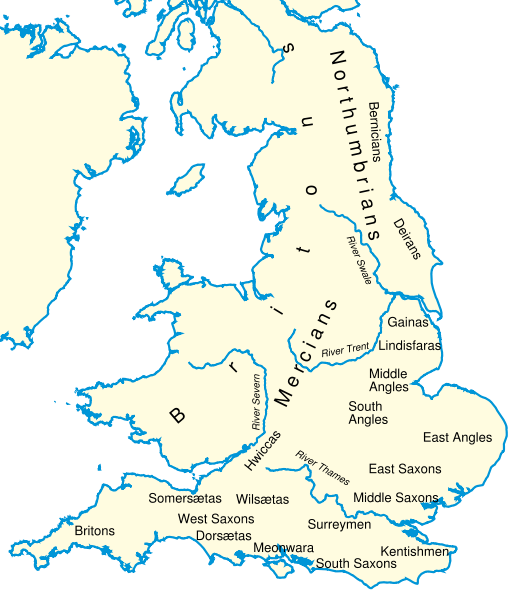
The slow invasion of
England - Settlements of the Germanic (Angle,
Saxon and Jute)
and indigenous (Briton, Hwicca) peoples around the year 600. 25
A Logic to our Immigrant Destinations in North America
While tribes with the same haplotypes didn't stay together, there is
still hope for figuring this all out. In my years doing genealogy
documents work, I've observed that family groups tended to end up in
the same general destinations in the colonies. Given the risks they
must have perceived in venturing to the New World, this makes a great
deal of sense. We see this among modern day immigrants. Not 20 miles
from my home are large Indian populations, Pakistani neighborhoods, and
others.
So it occurred to me to examine the ship records of David Dobson to see
if there are any large groupings of immigrants that have any logic to
their destinations. In other words, are we seeing any family proofs
based on the destinations they chose for their immigration? My source
for this is the work of David Dobson, "Directory of Scottish Settlers
in North America," and "Scots on the Chesapeake." I don't pretend that
these works are complete, but his work is extensive enough that it's a
good place to start. Lacking the resources to understand this
phenomenon in Canada or Australia/New Zealand, I'll deal only with
America.
There are six major points of immigration into North America before
the advent of Ellis Island in 1890. These were New Hampshire/Boston/New
York, Pennsylvania (Presumably Philadelphia), Halifax/Quebec, New Jersey, Virginia and
the Carolinas.
First, it's important to separate out those who were forced to
immigrate due to the troubles of 1715 and 1745. They could not choose
their destination. You'll see these mixed into the list below. I see
two Sinclairs who were convicted in the Jacobite Rebellion of 1715 and
sent to Virginia. It's interesting that they didn't go elsewhere. I'm
not certain of the economic or militaristic issues of the time that
determined this destination.
A full list of immigrants will follow. But first, it's interesting to
note that that we have one in 1760 from Nantz, France to Baltimore,
Maryland. In 1778, Sinclair & Hepburn were trading tobacco with
France. I believe there were other relationships between the Sinclairs
and France.
Virginia
Alexander Sinkler, progenitor of most of the Virginia line. Other than
one Arthur Sinclair, merchant skipper, I don't see any Sinclairs of the
Orkneys, Shetlands or Caithness settling in Virginia. However, there is
the possibility of the "Lost Child" coming into Virginia (see Family
Stories).
North Carolina (This seems to be a major landing point for Sinclairs)
Caithness and Collochlagy, Rea, Caithness - to - Wilmington, NC 1774
Glen Orchy – to – Wilmington, NC 1775
Greenock – to Wilmington, NC 1774
(This Greenock is likely not the port just west of Glasgow, but in Glen
Orchy)
Greenock, Glen Orchy – to – Wilmington, NC
Forsenain, Rea, Caithness – to – Wilmington, NC 1774
Isle of Jura - to – Mecklenberg, County, NC
Georgia
Holm, Orkney – to – Savanna, Ga. 1775
Kirkwall – to – Savanna, Ga 1775
Pennsylvania
Thurso, Caithness – to – Pennsylvania (gen. Arthur
St. Clair)
Stornoway – to – Philadelphia, PA 1775
Inverness – to – Philadelphia 1775
Where Are They Now?
These mapping tools are available in many countries. You'll see them on
the "Groupings" pages at the left where they are available. I've placed
more at this link.
You
can find these U.S. Census mapping tools at
Ancestry.com.
It's at least fun to know our actual geography in certain countries
where such data is available. I've parked the U.S. data here to
illustrate the range and possible logic of the distribution. What
it means, I can't yet discern. I believe there may be real value in
knowing the geography of the exact spellings of the name. For instance,
there's a story about General St. Clair visiting families in other
areas and if you track those families, you'll see the spelling of the
surname change at about the time of the purported visit.
You'll see
that this approach seems to be yielding real understanding of
the United Kingdom
distribution of our family.
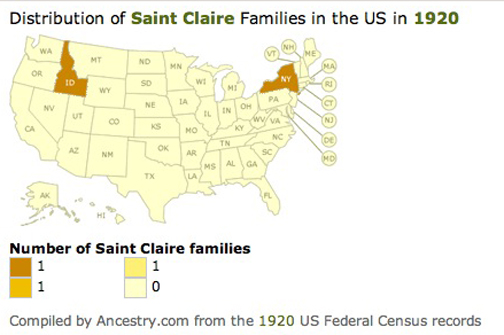
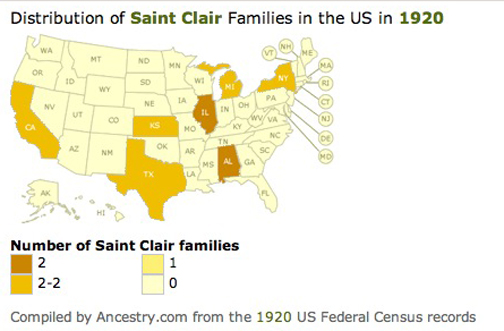
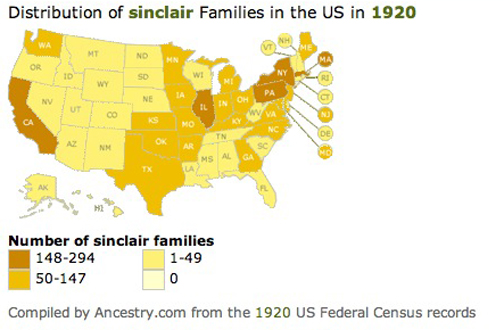
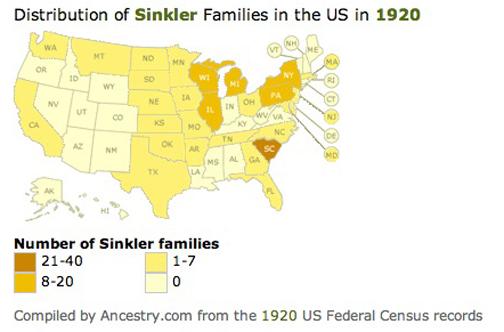
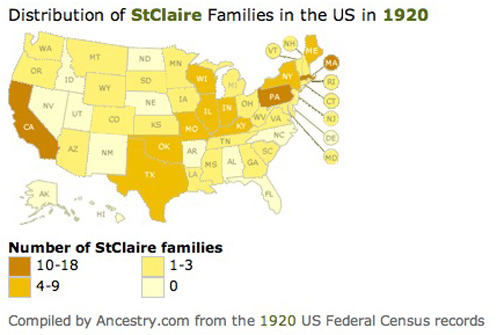
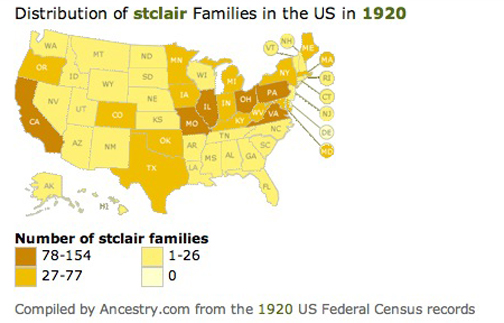
So Now What?
The next job for you, the reader, is to look through the genealogy
groupings in the navigation above left and click your group.
This is the part of the project where I rely on the documents trails of
the participants and the work of folks like Margaret Stokes, Antonia
Sinclair and so many family researchers to compare with the DNA
lineages and see if we can make sense of this all despite the mixing
that went on in the years preceding the migration out of the UK.
WE NEED YOUR HELP
This family and our history are simply too big for any one person to
solve. This "Genealogy Groupings" section is the part of our history
which you write. If you can help us add to the knowledge base of any
particular geography into which our family may have entered into a
country of immigration, or if you can add to our knowledge in the UK,
Norway or other areas, please send your thoughts (or better yet,
completely written up sections like Stan and Antonia did) to Steve and
I'll include it on this website.
Home | Contact
